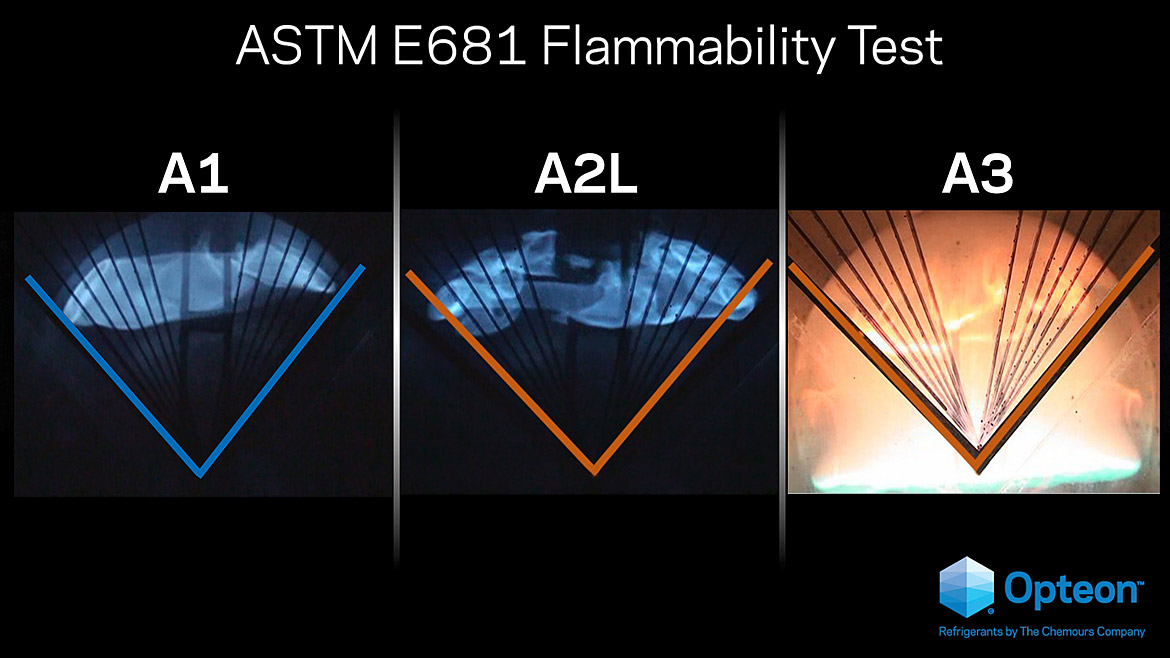Benefits of A2L Refrigerants and How the Cold Chain Can Transition

Image courtesy of PixelsEffect | Getty Images
For years, the HVACR industry has been preparing for the A2L refrigerant transition. That transition is now in full swing, bringing tremendous opportunities for businesses along the cold chain to embrace new-generation refrigeration technology. Although A2L technology is rooted in global climate concerns, there is much more to these refrigerants than meets the eye. A2Ls provide the HVACR industry, as well as the sectors depending on it, with solutions that significantly reduce global warming impact. Compared to many legacy systems, A2Ls also offer more energy-efficient, higher-capacity performance and a lower total cost of ownership based on capital and operating costs compared. A2Ls also enable safe, non-toxic working environments and a strong global supply.
Journey to A2Ls
Our modern understanding of refrigerants as gases starts in the mid-1870s, when ammonia was first used in compression refrigeration machines. This was followed by carbon dioxide (CO2) refrigerants in the early 1900s and the commercialization of propane refrigerants in the 1930s.
While these gases served their purpose early on, the common use of ammonia, sulfur dioxide and CO2 raised concerns over toxicity, safety and efficiency. In the 1930s, DuPont—the company from which Chemours spun off—invented Freon refrigerants. For generations, chlorofluorocarbon (CFC) and hydrochlorofluorocarbon (HCFC) refrigerants addressed safety concerns and solved several performance issues of their predecessors. However, their contribution to a growing hole in the ozone layer led to the invention of hydrofluorocarbons (HFCs), which offered excellent performance properties and zero ozone depletion potential (ODP). The 1987 Montreal Protocol accelerated adoption of HFCs by implementing a global phasedown of HCFCs.
While HFCs are not known to damage the ozone layer, they were later found to contribute to global warming. Enter a new solution, hydrofluoroolefin (HFO) refrigerants, which have zero ODP and significantly lower GWP. Also offering stellar performance properties, HFO and HFO blends have been in use for years in new equipment and retrofits. HFO products such as R-449A and R-513A provide lower-GWP solutions for numerous applications along the cold chain, including cold-storage warehouses and distributions centers, refrigerated transport, retail and restaurants.
The HFOs continue to be used industrywide amid the emerging presence of A2Ls—a group of refrigerants consisting of HFOs and HFO blends. Chemists have formulated A2Ls to further lower GWP and maximize the performance, operating efficiency, and energy savings of earlier-generation HFO refrigerants. To illustrate the GWP evolution, we start with two commonly used HFCs: R-404A and R-410A, with GWPs of 3,920 and 2,088, respectively. R-449A, an HFO, offers an improved GWP of 1,397. Finally, R-1234yf—an A2L component in many HFO and A2L blends—has a GWP of <1. R-454C, an A2L blend of R-32 and R-1234yf, has a GWP of <150.
A2L technology is rooted in the critical need to restore the health of the planet, but it also helps meet today’s refrigeration needs. We can be confident that the drive to adopt A2Ls is not a trend—it is here to stay.
Regulatory Influences
The U.S. EPA’s American Innovation and Manufacturing (AIM) Act largely determines the pace at which the industry adopts A2L technology. Currently, two components of the AIM Act come into play. Enacted on December 27, 2020, it mandates the phasedown of HFCs by 85% from historic baseline levels by 2036. The phasedown schedule started with a 10% reduction in 2022, followed by a further decrease in 2024, to 60% of baseline levels. The other contributor is the AIM Act’s Technology Transition Program, which starts in 2025 and will limit the use of HFCs in specific technology sectors and subsectors. To ensure regulatory compliance—and recognizing that the future lies in A2Ls—multiple commercial refrigeration OEMs have selected A2L replacements such as R-454A and R-454C, which stand to become major refrigerant products.
The key takeaway here is that the HFC phasedown has been strategically planned and is strongly supported throughout the industry. Whether you are an early adopter ready to go “all in” or need to walk before you run, the transition to A2Ls is designed to be a smooth one.

How Do A2Ls Differ from Other Refrigerants?
A2L refrigerants are named for their ASHRAE safety classification of mild flammability and nontoxicity. You will be hearing more and more about the “big three” A2Ls. These are R-454A, a strong contender for remote condensing units; R-454B, for air conditioning and heat pumps; and R-454C, positioned to transition supermarkets and industrial needs. Refrigerant manufacturers like Chemours are ramping up A2L production to ensure the pipeline is sufficient to meet a steady increase in demand.
The A2L classification was created because these refrigerants were slightly more flammable than A1s, not as flammable as A2s, and far less flammable than A3s. Lower-flammability A2L HFOs that are commercially available and OEM-approved are about four times less likely to form flammable concentrations during an accidental leak than highly flammable A3 alternatives such as propane and butane. The American Society for Testing Materials results demonstrate the difference in flammability between A1, A2L, and A3 refrigerants.
- A1s—do not propagate a flame.
- A2Ls—mild flammability; burning velocity of <10 cm/sec.
- A2s—lower flammability; burning velocity of >10 cm/sec.
- A3s—higher flammability; burning velocity of >10 cm/sec.
The vast difference in flame propagation between mildly flammable and highly flammable designations should ease concerns about A2L safety. HFOs are reliable, have undergone rigorous regulatory approval processes and are considered safe for their intended uses. To put the safety of HFOs in perspective, consider R-1234yf. This A2L has been used safely in vehicle AC systems for more than a decade and is found in over 95 million vehicles on U.S. roadways.
It is important to note that A2Ls are only for new equipment. Currently, there are no retrofit applications. Since A2Ls are mildly flammable, mixing them with A1s is unsafe, potentially harmful to equipment and performance, and illegal. A2L equipment and tools are designed to support safe use. Here are just a few examples: Systems using A2Ls are manufactured with leak detectors. A flammability label is required on A2L equipment, products, and literature. A2L cylinders have a red stripe and opposite-side threading to prevent mixing with A1s.
In addition to their low GWP, A2Ls support better system efficiency, lower energy consumption, low toxicity, and improved safety for use in a broad range of applications. They can also reduce operating costs throughout the life cycle of the refrigeration equipment. In addition, because A2Ls can be recovered, reclaimed and reused, they are critical across the many industries they touch and create a path to decarbonization.
A2L Training
Because more and more decision-makers are planning and implementing an A2L transition for their businesses, technicians need to get A2L training as quickly as possible. Although A2Ls perform similarly to legacy HFCs, there are critical differences—mainly, A2Ls have a higher flammability than nonflammable A1s. Training helps ensure staff work safely with these new-generation refrigerants and use them properly to allow for optimum performance. ACCA, RSES, and tool manufacturers offer free training on their websites.
Conclusion
A2Ls represent a valuable part of the growth strategy for almost any business along the cold chain. A2L technology can support the bottom line and sustainability initiatives critical to today’s business strategies. It offers exceptional performance that protects the integrity of your product and your corporate image. A2L equipment is becoming readily available, and A2Ls are being successfully used in a growing number of applications throughout the industry. Whether you are building a facility, looking for ways to increase energy efficiency, or need to replace older systems, it is important to carefully consider the benefits A2L technology can bring to your table.
Looking for a reprint of this article?
From high-res PDFs to custom plaques, order your copy today!






